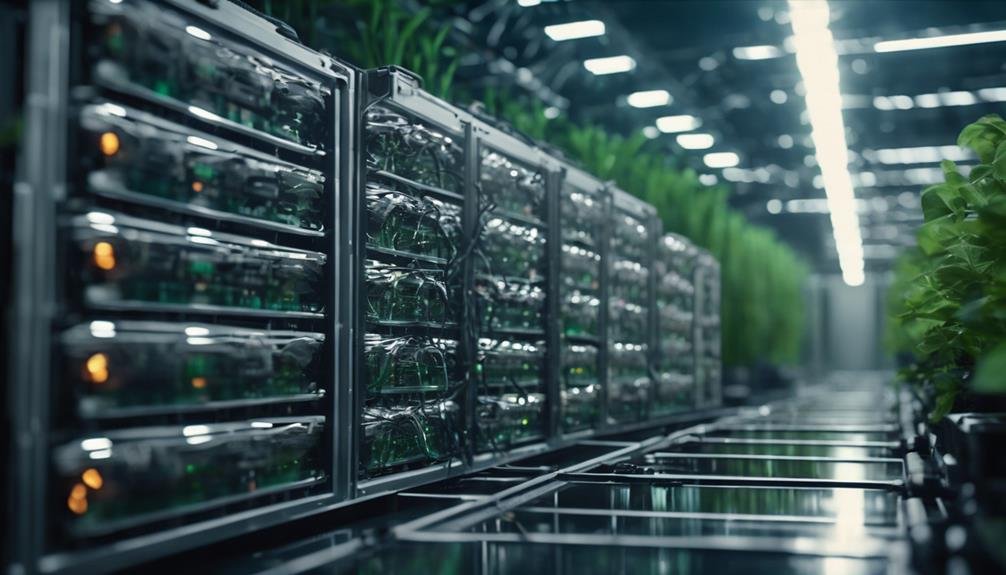To maximize energy efficiency in privacy coin mining, it is crucial to prioritize hardware selection, focusing on GPUs with low Joules per Terahash (J/TH) ratings and 80 Plus certified power supply units. Implementing processor load optimization techniques, such as dynamic workload allocation and underclocking, can also reduce energy consumption. Additionally, optimizing cooling systems, maintaining ideal operating temperatures, and utilizing heat recovery systems can further enhance efficiency. Regular software updates and tweaks can also optimize algorithms and reduce power consumption. By exploring these strategies and more, you can take the first step towards creating a more efficient and sustainable mining operation.
Table of Contents
Brief Overview of Maximize Privacy Coin Mining Energy Efficiency
- Select low Joules-per-THash-rated GPUs for improved mining energy efficiency.
- Choose energy-efficient 80 Plus certified PSUs with >80% conversion.
- Dynamically allocate processor loads for real-time power savings and minimal idle energy.
- Consider upgrading mining equipment regularly to ensure a balanced energy to output efficiency
Component Selection Strategies
To maximize energy efficiency in privacy coin mining, selecting the right components is vital, and a strategic approach to component selection can greatly impact overall operational costs and environmental sustainability. High energy efficiency is important in minimizing energy consumption while maintaining computational power. When selecting graphics processing units (GPUs), prioritize models with low Joules per Terahash (J/TH) ratings to enhance energy efficiency. Additionally, opt for 80 Plus certified power supply units (PSUs) to guarantee at least 80% of energy drawn from the wall is converted to usable power.
Investigate motherboards that support energy-efficient features and allow for ideal thermal management to further reduce power usage and extend the lifespan of mining hardware. Choosing RAM with lower voltage requirements and faster speeds can also decrease overall energy consumption while confirming the system can handle the demands of privacy coin algorithms efficiently. Regularly review and update mining hardware components to take advantage of advancements in technology that offer better performance-to-power ratios, confirming sustained energy efficiency. By selecting the right components, miners can create an energy-efficient setup that minimizes costs and environmental impact.
Heat Management Techniques
Effective heat management is essential in privacy coin mining, as excessive temperatures can greatly compromise the performance, lifespan, and overall energy efficiency of mining hardware. Implementing heat management techniques, such as high-performance cooling fans and liquid cooling systems, can notably reduce thermal output and extend the lifespan of mining hardware. Maintaining ideal operating temperatures through proper ventilation and cooling solutions is vital, as excessive heat can lead to hardware failures and decrease mining efficiency.
Regular cleaning of dust from cooling components and ensuring unobstructed airflow can enhance cooling performance and maintain consistent hash rates during mining operations. Additionally, using heat recovery systems can repurpose excess heat generated by mining rigs to provide warmth for residential or commercial spaces, effectively increasing overall energy efficiency. Monitoring temperatures with software tools and power meters allows miners to identify and address overheating issues proactively, ensuring that mining rigs operate within safe temperature ranges. By employing these heat management techniques, miners can minimize excessive heat and improve their mining hardware’s performance, leading to increased energy efficiency and profitability. Effective heat management is critical for maximizing the overall efficiency of mining operations.
Processor Load Optimization

Processor load optimization emerges as an essential strategy in privacy coin mining, enabling miners to strike a balance between computational power and energy consumption by dynamically allocating workload across multiple cores. This approach greatly enhances energy efficiency by reducing idle times and energy waste. Utilizing software tools like NiceHash or Minerstat allows miners to monitor and adjust their processor loads in real-time, achieving peak performance and minimizing energy consumption.
Implementing underclocking techniques can further lower the processor’s power requirements while maintaining adequate hash rates, thereby improving the watt-per-hash ratio in privacy coin mining operations. Additionally, choosing mining software that supports adaptive load management can dynamically allocate processing power based on network conditions, maximizing efficiency and profitability. Furthermore, targeting specific architectures like FPGAs or ASICs designed for privacy coins can yield higher energy efficiency compared to traditional CPU mining setups, resulting in reduced operational costs. By optimizing processor load, miners can maximize energy efficiency and stay competitive in the rapidly evolving landscape of privacy coin mining. Effective processor load optimization is essential for achieving a favorable balance between computational power and energy consumption.
Cooling System Evaluation
A well-designed cooling system is vital for maintaining ideal operating temperatures in mining rigs, as excessive heat can lead to premature hardware failure, reduced efficiency, and increased energy consumption. Cooling systems play a significant role in thermal management, and choosing the right solution can greatly impact energy efficiency. When evaluating cooling systems, miners should consider the trade-offs between air cooling and liquid cooling. Air cooling solutions, such as high-performance chassis fans, can achieve temperature regulation but may require more energy compared to liquid cooling systems. Liquid cooling systems, including liquid immersion cooling, can reduce energy consumption by up to 30% while providing superior thermal management.
Regular maintenance and monitoring are also important to guarantee optimal operating temperatures. Monitoring tools, such as thermal sensors and software applications, can provide real-time data on temperature and cooling efficiency. This enables miners to adjust their cooling strategies effectively to enhance energy use. By selecting the right cooling system and maintaining it properly, miners can prevent hardware failure, reduce energy consumption, and maximize energy efficiency in their mining rigs. Effective cooling system evaluation is essential to achieve peak performance and minimize costs in privacy coin mining.
Software Updates and Tweaks

Beyond the physical aspects of mining rig optimization, attention to software updates and tweaks can greatly contribute to enhanced energy efficiency in privacy coin mining. Regular software updates are essential for optimizing algorithms, fixing bugs, and reducing power consumption. Additionally, implementing low-power modes during periods of low activity can conserve electricity without sacrificing output.
Some key software tweaks to enhance energy efficiency include:
- Utilizing low-power modes to reduce energy usage during periods of low activity
- Implementing manual voltage regulation to fine-tune power supply to hardware
- Leveraging software tools to monitor real-time energy consumption and identify inefficiencies
Dual-Purpose Mining Solutions
Dual-purpose mining solutions, which combine cryptocurrency mining with supplemental heating capabilities, offer a compelling approach to maximizing energy efficiency in privacy coin mining operations. The Antminer S9 Space Heater Edition is a notable example of such a solution, allowing users to mine cryptocurrencies while converting excess heat into usable warmth for residential spaces. This innovative approach reduces heating costs and contributes to a more sustainable mining operation.
Energy Efficiency Metrics Analysis

Optimizing energy efficiency in privacy coin mining operations necessitates a thorough understanding of key performance metrics, with Joules per Hash (J/H) serving as a vital benchmark for evaluating the profitability and sustainability of mining activities. A lower J/H ratio indicates better energy efficiency and higher returns on investment, making it essential for miners to aim for ideal performance.
To achieve this, miners must carefully consider the following factors:
- Mining hardware selection: Choosing ASIC miners designed for specific privacy algorithms can greatly improve energy efficiency compared to general-purpose GPUs.
- Power consumption monitoring: Regular monitoring of power consumption using tools like watt meters helps identify inefficiencies and allows for adjustments to improve J/H ratios over time.
- Undervolting and cooling solutions: Implementing energy-efficient practices, such as undervolting and optimizing cooling solutions, can greatly reduce the overall power consumption of mining rigs.
Renewable Energy Integration
A considerable proportion of privacy coin mining operations can benefit substantially from integrating renewable energy sources, such as solar and wind power, into their infrastructure. By leveraging solar panels, mining rigs can produce sufficient energy to power operations, with a typical 5 kW solar system generating around 20 kWh per day, enough to run multiple ASIC miners. Additionally, wind energy can complement solar power, as it often peaks during different times of the day, enhancing the sustainability of mining activities. The combination of renewable energy with energy storage solutions, such as batteries, allows miners to maintain operations during low production periods, ensuring consistent performance and reducing reliance on grid power.
Integrating renewable energy sources can considerably reduce electricity costs, with potential savings of up to 70% in operational expenses for privacy coin mining operations. This not only enhances the environmental sustainability of mining activities but also reduces the carbon footprint by up to 80% compared to traditional fossil fuel-based electricity sources. By adopting renewable energy sources, mining operations can optimize energy efficiency, lower costs, and contribute to a more sustainable future for the industry.
Frequently Asked Questions
What Is the Most Energy Efficient Mining Rig?
The most energy-efficient mining rig is often determined by a thorough mining hardware comparison, considering factors such as energy consumption analysis, cooling solutions, and profitability metrics assessment to optimize sustainability and equipment lifespan.
What Is the Most Energy Efficient Mining Algorithm?
The most energy-efficient mining algorithm is often debated, with Proof of Stake (PoS) and Proof of Space offering markedly lower energy consumption compared to traditional Proof of Work (PoW) methods, optimizing hash rates while reducing mining difficulty.
What Is the Most Efficient Way of Mining Crypto?
Leveraging Proof of Stake, Renewable Energy, and Mining Pools enhances cryptocurrency mining efficiency. ASIC Miners, Cloud Mining, and GPU Mining optimize output, while Energy Audits, Sustainable Practices, and Hardware Optimization guarantee environmental responsibility and maximize Mining Rewards.
What Is the Best Privacy Coin to Mine?
The best privacy coin to mine varies depending on hardware and goals. Monero offers CPU-friendly mining, while Zcash provides high profitability for GPU rigs. Dash’s dual-tier network and Pirate Chain’s zk-SNARKS technology also present unique advantages.
Summarizing
Maximizing energy efficiency in privacy coin mining is essential for sustainable and cost-effective operations. By implementing component selection strategies, heat management techniques, and processor load optimization, mining systems can reduce energy consumption. Cooling system evaluation, software updates, and tweaks also contribute to enhanced efficiency. Dual-purpose mining solutions and renewable energy integration further minimize environmental impact. Energy efficiency metrics analysis enables informed decision-making. These strategies collectively optimize energy usage, ensuring a more viable and environmentally friendly mining process.




